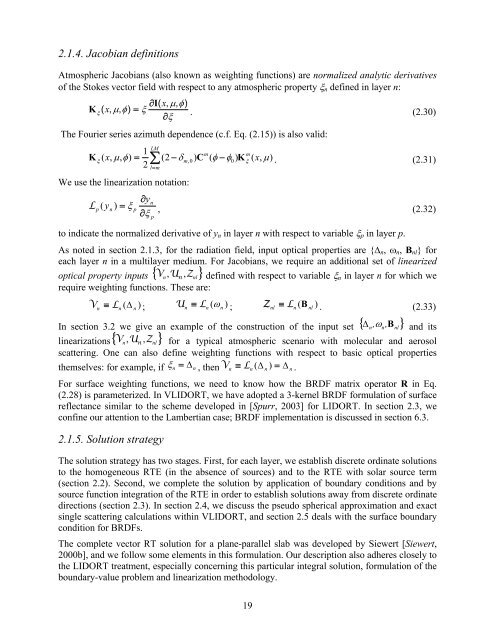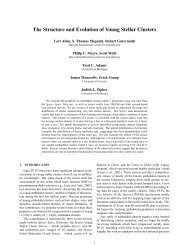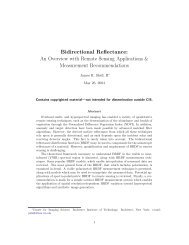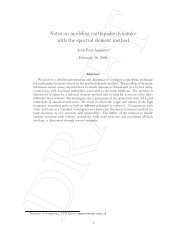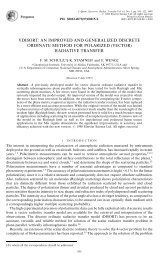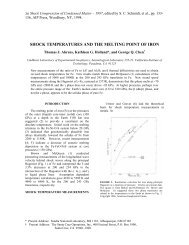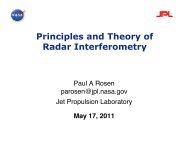m⎛ P⎞l( μ)0 0 0⎜⎟mmm ⎜ 0 Rl( μ)− Tl( μ)0 ⎟Pl( μ)= ⎜mm⎟ . (2.25)⎜0 − Tl( μ)Rl( μ)0⎟m⎝ 0 0 0 Pl( μ)⎠The “Greek matrices” Β l for 0 ≤ l ≤ LM contain the sets of expansion coefficients that define themmscattering law. The Pl(μ)matrices contain entries of normalized Legendre functions Pl(μ)andfunctions R ml(μ)and mlTl(μ)which are related to Pmn(μ)(for details, see for example [Siewert,2000b]).2.1.3. Boundary conditionsDiscrete ordinate RT is pure scattering theory: in a multilayer medium, it is only necessary tospecify the layer total optical thickness values Δ n , the layer total single scatter albedo ω n , and thelayer 4 x 4 matrices Β nl of expansion coefficients (l being the moment number) for the totalscattering. To complete the calculation of the radiation field in a stratified multilayer medium,we have the following boundary conditions:(Ι) No diffuse downwelling radiation at TOA. Thus for the first layer we have:+In( 0, μ,φ)= 0 . (n = 1) (2.26)(ΙΙ) Continuity of the upwelling and downwelling radiation fields at intermediateboundaries. If N TOTAL is the number of layers in the medium, then:±( ) ±I n − 1Δ n −1 = I n(0) . (n = 2,…N TOTAL ) (2.27)(ΙΙΙ) A surface reflection condition relating the upwelling and downwelling radiation fieldsat the bottom of the atmosphere:−+I ( , μ , φ)= ( μ,φ;μ′, φ′) ( , μ′, φ′nΔnR InΔn) . (n = N TOTAL ) (2.28)Here, reflection matrix R relates incident and reflected directions.The convention adopted here is to use a “+” suffix for downwelling solutions, and a “−” suffixfor upwelling radiation. Conditions (I) and (II) are obeyed by all Fourier components in theazimuthal series. For condition (III), it is necessary to construct a Fourier decomposition of theBRDF operator R to separate the azimuth dependence; we return to this issue in section 2.5.4.The Lambertian case (isotropic reflectance) only applies for Fourier component m = 0 and Eq.(2.28) then becomes:1⎡⎤−I = ⎢ ( − ) + ∫ + ′ ′ ′n( Δn,μ)2δm, 0R0E1μ0I0Tn−1exp λnΔnIn( Δn,μ ) μ dμ⎥ . (2.29)⎣0⎦Here, R 0 is the Lambertian albedo, E 1 = diag{1,0,0,0}, and T n− exp( − λnΔn)1 is the wholeatmosphereslant path optical depth for the solar beam.18
2.1.4. Jacobian definitionsAtmospheric Jacobians (also known as weighting functions) are normalized analytic derivativesof the Stokes vector field with respect to any atmospheric property ξ n defined in layer n:∂I(x,μ,φ)Kξ( x,μ,φ)= ξ∂ξ. (2.30)The Fourier series azimuth dependence (c.f. Eq. (2.15)) is also valid:KLM1mmx,μ,φ)= ∑ (2 − δm, 0)C ( φ − φ ) Kξ( x,μ). (2.31)2ξ(0l=mWe use the linearization notation:y∂y= ξ ∂nLp(n)pξ , (2.32)pto indicate the normalized derivative of y n in layer n with respect to variable ξ p in layer p.As noted in section 2.1.3, for the radiation field, input optical properties are {Δ n , ω n , B nl } foreach layer n in a multilayer medium. For Jacobians, we require an additional set of linearizedoptical property inputs { Vn , U n, Z nl} defined with respect to variable ξ n in layer n for which werequire weighting functions. These are:Vn≡ Ln( Δn) ; Un≡ Ln( ωn) ; Znl≡ Ln( Bnl) . (2.33)Δ and itslinearizations{ Vn , U n, Z nl} for a typical atmospheric scenario with molecular and aerosolscattering. One can also define weighting functions with respect to basic optical propertiesthemselves: for example, if ξn= Δn, thenV n≡ Ln( Δn) = Δn .In section 3.2 we give an example of the construction of the input set {n, ωn,Bnl}For surface weighting functions, we need to know how the BRDF matrix operator R in Eq.(2.28) is parameterized. In <strong>VLIDORT</strong>, we have adopted a 3-kernel BRDF formulation of surfacereflectance similar to the scheme developed in [Spurr, 2003] for LIDORT. In section 2.3, weconfine our attention to the Lambertian case; BRDF implementation is discussed in section 6.3.2.1.5. Solution strategyThe solution strategy has two stages. First, for each layer, we establish discrete ordinate solutionsto the homogeneous RTE (in the absence of sources) and to the RTE with solar source term(section 2.2). Second, we complete the solution by application of boundary conditions and bysource function integration of the RTE in order to establish solutions away from discrete ordinatedirections (section 2.3). In section 2.4, we discuss the pseudo spherical approximation and exactsingle scattering calculations within <strong>VLIDORT</strong>, and section 2.5 deals with the surface boundarycondition for BRDFs.The complete vector RT solution for a plane-parallel slab was developed by Siewert [Siewert,2000b], and we follow some elements in this formulation. Our description also adheres closely tothe LIDORT treatment, especially concerning this particular integral solution, formulation of theboundary-value problem and linearization methodology.19
- Page 1: User’s GuideVLIDORTVersion 2.6Rob
- Page 5 and 6: Table of Contents1H1. Introduction
- Page 7 and 8: 1. Introduction to VLIDORT1.1. Hist
- Page 9 and 10: Table 1.1 Major features of LIDORT
- Page 11 and 12: In 2006, R. Spurr was invited to co
- Page 13: corrections, and sphericity correct
- Page 16 and 17: Matrix Π relates scattering and in
- Page 20 and 21: In the following sections, we suppr
- Page 22 and 23: of the single scatter albedo ω and
- Page 24 and 25: Here T n−1 is the solar beam tran
- Page 26 and 27: ~ + ~ ~ (1)~ ~ + ~ ~ (2)~ ~ − ~ 1
- Page 28 and 29: The solution proceeds first by the
- Page 30 and 31: Linearizations. Derivatives of all
- Page 32 and 33: For the plane-parallel case, we hav
- Page 34 and 35: One of the features of the above ou
- Page 36 and 37: L↑↑ ↑k (cot n −cotn −1)[
- Page 38 and 39: Note the use of the profile-column
- Page 40 and 41: βl,aer(1)(2)fz1e1βl+ ( 1−f ) z2
- Page 42 and 43: For BRDF input, it is necessary for
- Page 44 and 45: streams were used in the half space
- Page 46 and 47: anded tri-diagonal matrix A contain
- Page 48 and 49: in place to aid with the LU-decompo
- Page 50 and 51: In earlier versions of LIDORT and V
- Page 53 and 54: 4. The VLIDORT 2.6 package4.1. Over
- Page 55 and 56: (discrete ordinates), so that dimen
- Page 57 and 58: Table 4.2 Summary of VLIDORT I/O Ty
- Page 59 and 60: Table 4.3. Module files in VLIDORT
- Page 61 and 62: Finally, modules vlidort_ls_correct
- Page 63 and 64: end program main_VLIDORT4.3.2. Conf
- Page 65 and 66: $(VLID_DEF_PATH)/vlidort_sup_brdf_d
- Page 67 and 68: Finally, the command to build the d
- Page 69 and 70:
Here, “s” indicates you want to
- Page 71 and 72:
The main difference between “vlid
- Page 73 and 74:
to both VLIDORT and the given VSLEA
- Page 75 and 76:
STATUS_INPUTREAD is equal to 4 (VLI
- Page 77 and 78:
5. ReferencesAnderson, E., Z. Bai,
- Page 79 and 80:
Mishchenko, M.I., and L.D. Travis,
- Page 81:
Stamnes K., S-C. Tsay, W. Wiscombe,
- Page 84 and 85:
Table A2: Type Structure VLIDORT_Fi
- Page 86 and 87:
DO_WRITE_FOURIER Logical (I) Flag f
- Page 88 and 89:
USER_LEVELS (o) Real*8 (IO) Array o
- Page 90 and 91:
angle s, Stokes parameter S, and di
- Page 92 and 93:
DO_SLEAVE_WFS Logical (IO) Flag for
- Page 94 and 95:
6.1.1.8. VLIDORT linearized outputs
- Page 96 and 97:
NFINELAYERS Integer Number of fine
- Page 98 and 99:
6.1.2.4. VLIDORT linearized modifie
- Page 100 and 101:
The output file contains (for all 3
- Page 102 and 103:
The first call is the baseline calc
- Page 104 and 105:
for a 2-parameter Gamma-function si
- Page 106 and 107:
Remark. In VLIDORT, the BRDF is a 4
- Page 108 and 109:
6.3.3.1. Input and output type stru
- Page 110 and 111:
Table C: Type Structure VBRDF_LinSu
- Page 112 and 113:
Special note regarding Cox-Munk typ
- Page 114 and 115:
squared parameter, so that Jacobian
- Page 116 and 117:
6.4. SLEAVE SupplementHere, the sur
- Page 118 and 119:
is possible to define Jacobians wit
- Page 120 and 121:
etween 0 and 90 degrees.N_USER_OBSG
- Page 122:
6.4.4.2 SLEAVE configuration file c


